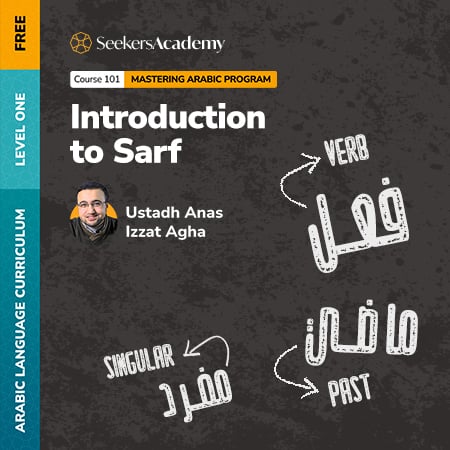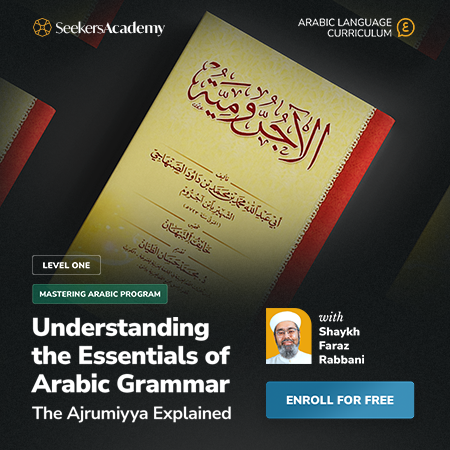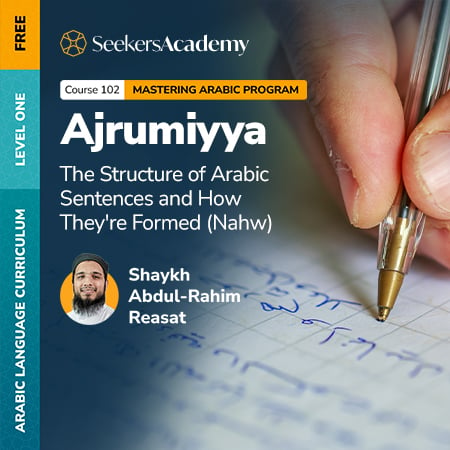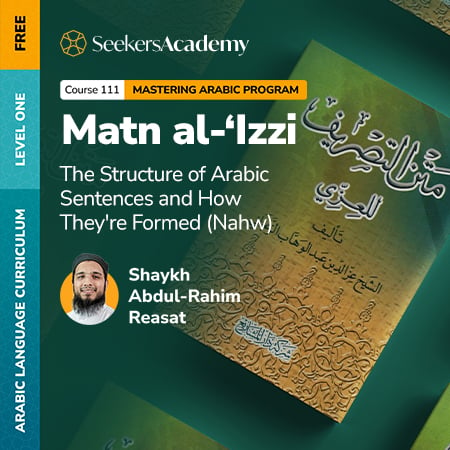
هذه الدورة من دورات المستوى الأول في برنامج إتقان العربية، يتلقى فيها الطالب قدرًا جيدًا من الكلمات العربية الأصيلة والتراكيب المتينة والعبارات البليغة والحِكم الفائقة والأشعار الرائقة.
وهذا الكتاب من الكتب المفتاحية للمبتدئين الذين يريدون تنمية مخزونهم اللغوي والأدبي والبياني بما يحفظونه ويقرؤونه من آداب العرب.
- Teacher: anas ezzatagha
كتاب "المختار من فرائد اللغة والأدب" هو كتابنا الذي نتناوله بالتعليق والبيان في هذه الدورة، وقد كتبه مؤلفه بعد أن جال في المعاهد والمدارس الشرعية واللغوية، فوجد نقصًا واضحًا عند الطلبة في قراءة آداب العرب وحِكَمهم وأشعارهم، ووجدَ بيانهم ضعيفًا لأن مخزونهم اللغويَّ ضعيفٌ. وقد فتَّش حوله في كتب الأدب المشهورة فوجدها عسيرة على المبتدئين، فكان أن انتقى كتابه هذا من عدد من الكتب وأودعه فرائد لغويةً ولطائفَ أدبية تُهذِّب لسان الطالب وتُرَقِّي بيانَه وتُفتِّحُ ذائقتَه لهم كلام العرب وطرائقهم في التعبير.
هذه الدورة للشباب والباحثين في العلوم الشرعية وعموم المثقّفين، ممن يريد أن ينمّي مخزونه اللغوي والأدبي ويستعينَ بالمفردات والتراكيب الجديدة التي يحصِّلها في تقويم بيانه وتحسينه وتجويده.
- اكتساب مفردات لغوية جديدة.
- اكتساب تراكيبَ لغويةٍ جديدة.
- تعرُّف طرائق العرب في التعبير وعاداتِهم الفعلية.
- الاطلاع على نماذج جيدة من الشعر العربي وفهم مقاصدها العامة.
- التمكن من نثرِ الشعر نثرًا عاليًا مبينًا.
- تفتح الذائقة البيانية والتحليلية عند الطالب.

هذه الدورة من دورات المستوى الأول في برنامج إتقان العربية، يتلقى فيها الطالب الخريطة العامة والمبادئ الرئيسة والمعلومات الإجماليةَ في علم النحو، وتجعلُه أهلًا لدراسة ما بعدها من الدورات العلمية والكتب المتينة في هذا العلم.
وهذا الكتاب من الكتب المفتاحية للمبتدئين، وفيه قواعد وتطبيقات حسَنةٌ، وقد اعتمدته عدد من المعاهد الشرعية ليكون أوَّلَ مقرراتها النحوية.
- Teacher: anas ezzatagha
كتاب "فتح الأبواب للمبتئين بعلم الإعراب" هو كتابنا الذي نشرحه، وقد كتبه مؤلفه ليكون تمهيدًا متينًا دقيقًا للمبتدئين بعلم الإعراب، وقد عرضَه على أساتذة كبار مختصين في هذا العلم فارتضَوه، واعتمدته عدد من المعاهد الشرعية في مرعش وغازي عنتاب وأورفة وإسطنبول.
وتأتي أهمية الكتاب مِن أنّ مؤلفه كانت له صلة كبيرة بالمبتدئين ومعرفة بمشكلاتهم في تلقي علم النحو وإشكالاتهم حين قراءة المتون العلمية المعتبرة، فصنَّف لهم هذا الكتاب الذي أقامه على تقسيم صارم للمباحث وَفق أقسام الكلمة الثلاثة: الاسم والفعل والحرف، وامتاز بأنه جعل مبحثًا خاصًّما متميزًا للحرف بخلاف كتب المبتئين المشهورة، وأتى له بأمثلة يسيرة سهلة، وختمه بطرائق الإعراب العملي وخطواته، ثم بإعراب أمثلة الكتاب كاملة، ثم بتدريبات عملية تدرَّج فيها من السهل إلى الصعب بما يناسب مستوى الطلاب، ثم ألحق به موجزًا عن أبرز قواعد الكتابة العربية ليربط بين اللفظ والمكتوب ويبيِّن إلى أن العناية باللفظ لا تقلُّ أهمية عن العناية بالمكتوب وضبطِه، لأنه صورةٌ له.
هذه الدورة للشباب والباحثين في العلوم الشرعية وعموم المثقّفين، ممن يريد أن يبدأ بداية صحيحة في تعلم النحو، أو ممن يريد أن يرمِّم معلوماته السابقة في هذا العلم.
- فهم الأبواب الرئيسة والخريطة العامة لهذا العلم.
- ضبط المصطلحات المشهورة في علم النحو.
- إتقان القواعد الإجمالية دون تفصيلات.
- القدرة على التمثيل بجمل صحيحة نحويًّا غيرِ معقَّدة.
- التنبه للأخطاء التركيبية الرئيسةِ التي يقع فيها المتكلمون، والقدرةُ على تصويبها.
- معرفة المواقع الرئيسة للكلمات في التركيب لأجل تفكيك وفهمُ مواقعها واختلاف المعنى بها.

تعرض هذه الدورة أشهر مباحث علم الإملاء التي لا يسعُ متعلمَ العربية جهلُها، وتعينه على ضبط كتابته وفق القوانين التي استنبطها علماؤنا، وعلى استعمال علامات الترقيم في مكانها المناسب
- Teacher: Abdulkader Tabbash
- القدرة على تمييز نوعي الهمزة الأولية وأنواع الهمزتين المتوسطة والمتطرفة، وكتابتها وفق القواعد.
- القدرة على تمييز نوعي الألف اللينة: المشالة والممالة، وكتابتها وفق القواعد.
- القدرة على تمييز مواضع النقص والزيادة في الكتابة.
- القدرة على تمييز مواضع الوصل والفصل في الكتابة.
- استعمال علامات الترقيم بدقة وفق القواعد.

This course is suitable for beginners in morphology, who want to use it to understand the Quran and Sunnah.
The author of the book is the erudite scholar, Shaykh Al-Azhari Haroun Abdul Raziq, one of the prominent scholars of the late nineteenth and early twentieth centuries.
The textbook is one of the best books in morphology because it elucidates the most important morphological rules for beginners.
Through this course, the student will be able to understand how Arabic words are formed and use this knowledge to understand speech accurately, especially the Holy Quran and the Noble Sunnah.
This course is an explanation of one of the instrumental Islamic sciences, therefore, one must study this before taking courses on the sciences of maqasid (aims of Islam) such as jurisprudence and exegesis of the Quran...
The outcome of this course will show the student that it is an important tool in the analysis of legal discourse. It will therefore bring great benefit in correctly acquiring knowledge of jurisprudence, exegesis, and other sciences
This course seeks to examines and elucidate the forms and meanings of Arabic words, and how words can be affected by changes in form and in meaning.
- Teacher: anas ezzatagha
This book "The Epitome of Elegance in the Art of Morphology" teaches the novice basic morphology and lists its basic and most important principles.
This book deals with the conjugation of verbs and the changes that affect nouns - and the changes that are common to both - and above all, it provides basic introductions to the definition of this science and its foundational principles.
This book is important, because it has been adopted by many Islamic institutes today, and has been expounded on by several professors and scholars.
It is one of the books recommended by contemporary linguists to start learning this science because it can provide what is necessary to know for beginners in morphology.
This book is aimed at beginners, therefore, it is suitable for our introductory level offering.
I have written a commentary on this book to clarify some vague short expressions, to supplement the examples given in it, to provide extra necessary principles, and to point out some of the mistakes present in the book which naturally occur in any book written by man. This commentary is very important and must be used alongside the teaching of this book.
- The course is suitable for young people who are proficient in reading and writing, and want to study Islamic sciences.
- This course is aimed at anyone who wants to study the sciences of Islam and understand them correctly.
- This is the first course of the Mastering Arabic Program. The student must be proficient in reading and writing Arabic well and have completed course 903 from the Learning Arabic Curriculum.
- This course is open to anyone who wants to expand their understanding of the Arabic language, who wants to understand the changes in Arabic word forms, and wants to benefit from recognizing the superiority of this honorable language.
- Be able to discern and understand the main principles of morphology.
- To know the terminology used in this science.
- To distinguish between different Arabic word forms and know their impact on speech.
- Understand the impact of the morphological forms in creating the general meaning of text.
- Use a root word in Arabic and find its derivatives in a practical way.
- To benefit from this course by acquiring a preliminary understanding of other sciences.

The Ajrumiyya is the first step in the formal study of Arabic grammar (nahw) for students of the Arabic language. It is a blessed and beneficial text, taught for centuries across the Muslim world. It has hundreds of commentaries. It is a short and clear yet comprehensive text. The class assumes the ability to understand basic Arabic, and to follow simple Arabic examples.
The Ajrumiyya has great importance in the history of Arabic grammar, especially as a teaching text. It made the core concepts of grammar (nahw) easier for beginning students. It serves as a time-tested first step in this noble science that is the key to understanding the Quran, Sunna, and Islamic sciences soundly.
- Anyone seeking to begin the formal study of the Arabic language, after having basic to intermediate exposure to learning Arabic and having some basic ability to read and understand simple Arabic sentences.
- This course is essential for students of Arabic grammar and of the Islamic sciences, as it provides a comprehensive yet clear introduction to the science of nahw.
- This text is commonly memorized by students. It is encouraged that serious students memorize both the text and the definitions given.
- Describe what the science of Arabic grammar is and how it developed
- Organize the rules of the Arabic language into structured map (this is how the Ajrumiyya is written)
- Explain the key terms and questions of the science of Arabic grammar
- Recognize the rules of Arabic grammar at work in authentic uses of the ancient Arabic language
- Use the rules of Arabic grammar to analyze the ancient Arabic language

The science of Arabic grammar (nahw) is the oldest and one of the most important of all the Islamic sciences. It began in the time of the Companions, when the mistakes of non-Arabian converts to Islam began adulterating the linguistic purity of the ancient Arabic language. The early grammarians preserved this ancient language through formal rules, thereby preserving our ability to understand the Qur’an and Sunna. Take this course to understand what Arabic grammar is, how it developed, its technical vocabulary, its most important questions, and how to use it to analyze the ancient Arabic language, which is the key to understanding the Qur’an, the Sunna, and all of the Islamic sciences. This course is taught in English but it is not a first-level course in Arabic grammar. Proficiency in the Arabic language and in its most important rules are a prerequisite for this course.
- Teacher: Shaykh Abdul-Rahim Reasat
This course is a detailed explaination of the Ajrumiyya (or, alternatively, the “Ajurrumiyya”). The Ajrumiyya is the most popular traditional primer in the science of Arabic grammar. Written seven hundred years ago by the Berber scholar and saint, Muhammad b. Muhammad al-Sinhaji (d. 723 AH / 1323 CE), it has been the foundation for studies in Arabic grammar for students of sacred knowledge all over the world. It has dozens of important commentaries and glosses and is popularly memorized, sometimes in its original prose-form and sometimes in one of its versified versions. The secret of its popularity is frequently ascribed to the sincerity of its author, who wrote it while sitting before the Ka‘ba. He tested his sincerity by casting it into the sea. Only when he saw it washed ashore with its writing intact did he begin teaching it to others. A translation of the Ajrumiyya is provided along with the course materials.
- This course is cross-listed in Step Two and Learn Arabic
- This is an advanced course in the
- Learning Arabic curriculum
- Students who register for this course must be able to:
(a) conjugate verbs in each of their ten morphological forms;
(b) identify the ism fāʿil, ism mafʿūl, ism tafḍīl, al-ṣifa al-mushabbaha, the ism ẓarf, ism āla, and the maṣdar;
(c) know all important rules related to masculine, feminine, singular, dual, and plural nouns;
(d) comfortably work with nominal sentences (jumla ismiyya), verbal sentences (jumla fiʿliyya), and conditional sentences (shart and jawab al-shart); and (e) use the Hans Wehr dictionary. Some Arabic vocabulary is also required.
- This course is a key prerequisite for all courses in Steps Three and Four
- Describe what the science of Arabic grammar is and how it developed
- Organize the rules of the Arabic language into structured map (this is how the Ajrumiyya is written)
- Explain the key terms and questions of the science of Arabic grammar
- Recognize the rules of Arabic grammar at work in authentic uses of the ancient Arabic language
- Use the rules of Arabic grammar to analyze the ancient Arabic language

Language is a systematic combination of individual words. These words have meanings which express what is happening, by whom, when, and how. Knowing how to recognise and form these words is the scope of the science of Morphology.
In Arabic, a single root word is taken and altered in many ways to imbue it with particular meanings. This alteration is called ‘Sarf’ in Arabic, which can be understood to mean ‘changing’ or ‘morphing.
A strong grasp of this science is important for anyone wishing to successfully study Arabic, or any science which is taught through Arabic. It is also a crucial ingredient in gaining a deep appreciation of the beauty of the Qur’an.
- Teacher: Shaykh Abdul-Rahim Reasat
This text, known as ‘Matan al ‘Izzi, authored by ‘Izz al Din, ‘Abd al Wahhab b. Ibrahim al Zanjani, has been taught as the foundational text in this science for hundreds of years. With its clear and gradually progessive layout, it is an excellent place to start to learn the foundation principles of the science.
- This course is cross-listed in Step Two and Learn Arabic
- This is an advanced course in the
- Learning Arabic curriculum
- Students who register for this course must be able to:
(a) conjugate verbs in each of their ten morphological forms;
(b) identify the ism fāʿil, ism mafʿūl, ism tafḍīl, al-ṣifa al-mushabbaha, the ism ẓarf, ism āla, and the maṣdar;
(c) know all important rules related to masculine, feminine, singular, dual, and plural nouns;
(d) comfortably work with nominal sentences (jumla ismiyya), verbal sentences (jumla fiʿliyya), and conditional sentences (shart and jawab al-shart); and
(e) use the Hans Wehrdictionary. Some Arabic vocabulary is also required.
This course is a key prerequisite for all courses in Level Three and Four- About the text and its author.
- What Morphology is.
- The standard form (al Mujarrad) and its variants for words which have a three, and a four-letter root.
- How to conjugate the past, present, and future verbs for all of them.
- What verbs with sound letters are, and what verbs with weak letters are.
- How verbs with weak letters are categorized and conjugated.
- What the various forms of nouns are, and how to alter them to suit the context.